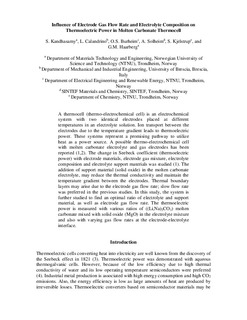Influence of electrode gas flow rate and electrolyte composition on thermoelectric power in molten carbonate thermocell
Kandhasamy, Sathiyaraj; Calandrino, Luca; Burheim, Odne Stokke; Solheim, Asbjørn; Kjelstrup, Signe Helene; Haarberg, Geir Martin
Journal article
Submitted version
Permanent lenke
http://hdl.handle.net/11250/2464248Utgivelsesdato
2016Metadata
Vis full innførselSamlinger
- Institutt for fysikk [2677]
- Institutt for kjemi [1386]
- Institutt for materialteknologi [2527]
- Publikasjoner fra CRIStin - NTNU [37703]
Sammendrag
A thermocell (thermo-electrochemical cell) is an electrochemical system with two identical electrodes placed at different temperatures in an electrolyte solution. Ion transport between the electrodes due to the temperature gradient leads to thermoelectric power. These systems represent a promising pathway to utilize heat as a power source. A possible thermo-electrochemical cell with molten carbonate electrolyte and gas electrodes has been reported (1,2). The change in Seebeck coefficient (thermoelectric power) with electrode materials, electrode gas mixture, electrolyte composition and electrolyte support materials was studied (1). The addition of support material (solid oxide) in the molten carbonate electrolyte, may reduce the thermal conductivity and maintain the temperature gradient between the electrodes. Thermal boundary layers may arise due to the electrode gas flow rate; slow flow rate was preferred in the previous studies. In this study, the system is further studied to find an optimal ratio of electrolyte and support material, as well as electrode gas flow rate. The thermoelectric power is measured with various ratios of ((Li,Na)2CO3) molten carbonate mixed with solid oxide (MgO) in the electrolyte mixture and also with varying gas flow rates at the electrode-electrolyte interface.
